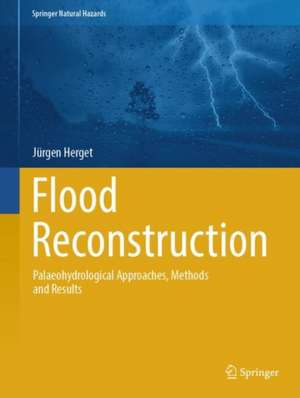Flood reconstruction: Palaeohydrological approaches, methods and results: Springer Natural Hazards
Autor Jürgen Hergeten Limba Engleză Hardback – 16 oct 2024
These marks may exist in the form of historical records and descriptions, which vary in extent across different cultural contexts. In addition to historical records, natural indicators like deposited sediments or erosion traces provide valuable information about past flood levels. This is particularly important for prehistoric periods and for regions without dense settlements and related gauges. These investigations lead to further questions about maximum flood levels and the earliest recorded observations.
This book addresses these questions by exploring the reconstruction of floods from both historical and prehistoric times. It explains and discusses methods and results for beginners with diverse backgrounds in disciplines such as earth sciences, hydrology, history, and engineering. Extensive and carefully selected reference lists offer access to additional information.
Din seria Springer Natural Hazards
- 15%
 Preț: 697.15 lei
Preț: 697.15 lei - 18%
 Preț: 1011.45 lei
Preț: 1011.45 lei - 15%
 Preț: 647.40 lei
Preț: 647.40 lei - 18%
 Preț: 726.52 lei
Preț: 726.52 lei - 15%
 Preț: 641.03 lei
Preț: 641.03 lei - 15%
 Preț: 644.95 lei
Preț: 644.95 lei - 18%
 Preț: 915.79 lei
Preț: 915.79 lei - 18%
 Preț: 1234.32 lei
Preț: 1234.32 lei - 18%
 Preț: 950.66 lei
Preț: 950.66 lei - 15%
 Preț: 639.25 lei
Preț: 639.25 lei - 18%
 Preț: 956.18 lei
Preț: 956.18 lei - 18%
 Preț: 729.06 lei
Preț: 729.06 lei - 15%
 Preț: 697.65 lei
Preț: 697.65 lei - 18%
 Preț: 1225.48 lei
Preț: 1225.48 lei - 18%
 Preț: 1398.80 lei
Preț: 1398.80 lei - 18%
 Preț: 1408.71 lei
Preț: 1408.71 lei - 18%
 Preț: 730.79 lei
Preț: 730.79 lei - 15%
 Preț: 643.00 lei
Preț: 643.00 lei - 24%
 Preț: 885.20 lei
Preț: 885.20 lei - 15%
 Preț: 706.16 lei
Preț: 706.16 lei - 24%
 Preț: 986.01 lei
Preț: 986.01 lei
Preț: 707.00 lei
Preț vechi: 831.76 lei
-15% Nou
Puncte Express: 1061
Preț estimativ în valută:
135.33€ • 147.04$ • 113.75£
135.33€ • 147.04$ • 113.75£
Carte disponibilă
Livrare economică 31 martie-14 aprilie
Preluare comenzi: 021 569.72.76
Specificații
ISBN-13: 9783031668142
ISBN-10: 3031668146
Pagini: 180
Ilustrații: Approx. 180 p. 120 illus. in color.
Dimensiuni: 210 x 279 mm
Greutate: 0.7 kg
Ediția:2025
Editura: Springer Nature Switzerland
Colecția Springer
Seria Springer Natural Hazards
Locul publicării:Cham, Switzerland
ISBN-10: 3031668146
Pagini: 180
Ilustrații: Approx. 180 p. 120 illus. in color.
Dimensiuni: 210 x 279 mm
Greutate: 0.7 kg
Ediția:2025
Editura: Springer Nature Switzerland
Colecția Springer
Seria Springer Natural Hazards
Locul publicării:Cham, Switzerland
Cuprins
You can learn from bad experience – reasons and background for palaeohydrological investigations.- Methods of parameter estimation.- Floods in historic times.- Another process pattern: outburst floods.- Megafloods in Pleistocene times.- Refill of oceanic basins in Earth’s history.- Conclusion and perspectives.
Notă biografică
Prof. Dr. Jürgen Herget studied geography with geology and hydrology at Ruhr-Universität Bochum in 1986-1992. In his dissertation in 1996 he investigated the terraces of the River Lippe and in his habilitation in 2003 he reconstructed the Pleistocene ice-dammed lake outburst floods in the Altai Mountains, Siberia. Since 2004 he is professor of physical geography at Bonn University, Germany. In his scientific work, he focusses on palaeohydrology, flood reconstruction and geomorphology.
Textul de pe ultima copertă
Floods are among the most common and consequential natural disasters on Earth, occurring in all natural areas at all times. Yet, they often surprise us with their unexpected magnitude and the damage they cause. Terms like century and millennium floods quickly become widespread, but what do we really know about the floods of the past? How can we truly classify events like the Mississippi flood of 1993, the Elbe flood of 2002, or the Pakistan flood of 2010? Have such floods occurred before, or are they unprecedented, perhaps even consequences of ongoing climate change? To answer these questions, we must look into the past. However, river level records are often limited in duration, rarely extending back more than a hundred years, and many regions lack any measured values at all. Nonetheless, floods have left their marks.
These marks may exist in the form of historical records and descriptions, which vary in extent across different cultural contexts. In addition to historical records, natural indicators like deposited sediments or erosion traces provide valuable information about past flood levels. This is particularly important for prehistoric periods and for regions without dense settlements and related gauges. These investigations lead to further questions about maximum flood levels and the earliest recorded observations.
This book addresses these questions by exploring the reconstruction of floods from both historical and prehistoric times. It explains and discusses methods and results for beginners with diverse backgrounds in disciplines such as earth sciences, hydrology, history, and engineering. Extensive and carefully selected reference lists offer access to additional information.
These marks may exist in the form of historical records and descriptions, which vary in extent across different cultural contexts. In addition to historical records, natural indicators like deposited sediments or erosion traces provide valuable information about past flood levels. This is particularly important for prehistoric periods and for regions without dense settlements and related gauges. These investigations lead to further questions about maximum flood levels and the earliest recorded observations.
This book addresses these questions by exploring the reconstruction of floods from both historical and prehistoric times. It explains and discusses methods and results for beginners with diverse backgrounds in disciplines such as earth sciences, hydrology, history, and engineering. Extensive and carefully selected reference lists offer access to additional information.
Caracteristici
Presents the reconstruction of floods from historical and prehistoric times Explains and discusses methods and results Written by an expert in the field
